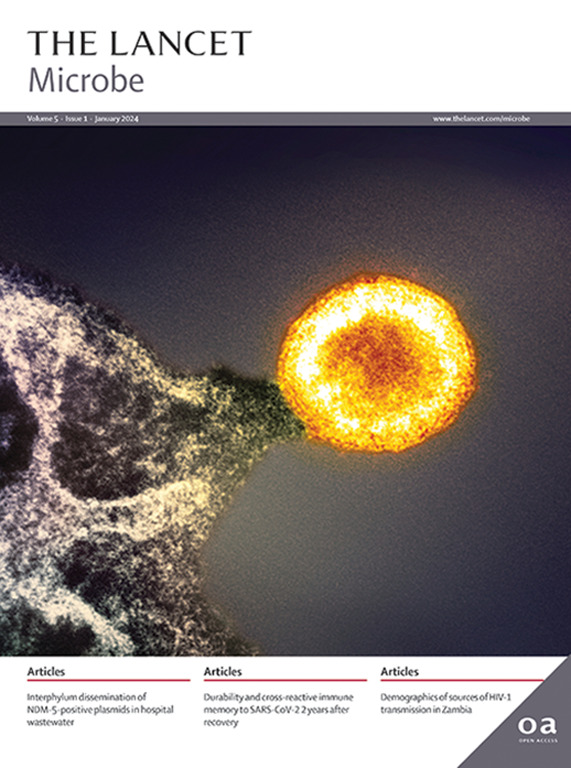Severe acute respiratory syndrome (SARS) mathematical models and disease parameters: a systematic review
IF 20.4
1区 生物学
Q1 INFECTIOUS DISEASES
引用次数: 0
Abstract
SARS-CoV-1 was the first documented coronavirus to cause an acute epidemic in humans and remains a priority pathogen owing to the risk of re-emergence. Robust estimates of key epidemiological parameters are essential to guide outbreak responses and inform mathematical models. Existing systematic reviews have been limited in scope, warranting a comprehensive and up-to-date review. We conducted a systematic review (PROSPERO CRD42023393345) of studies of severe acute respiratory syndrome (SARS) transmission models and parameters characterising the transmission, evolution, natural history, severity, risk factors, and seroprevalence of SARS-CoV-1. Information was extracted using a custom database and quality assessment tool. We extracted data on 519 parameters, 243 risk factors, and 112 models from 289 papers. We found that SARS is characterised by high lethality (case-fatality ratio, 10·9%), transmissibility (R0 range, 1·1–4·59), and superspreading events (approximately 91% of SARS-CoV-1 infections can be attributed to 20% of individuals who were most infectious). Infection risk was the highest among health-care workers and close contacts of infected individuals. Severe disease and death were associated with age and existing comorbidities. The natural history of SARS was poorly characterised, except for the incubation and mean onset-to-hospitalisation delays. The extracted data were compiled into our associated R package, epireview, which can be updated to incorporate novel findings, thus providing a key resource for informing response to future coronavirus outbreaks. By making data accessible through an updatable database, we support rapid, evidence-informed responses to potential re-emergence of SARS-CoV-1 or related coronaviruses.
严重急性呼吸系统综合征(SARS)数学模型和疾病参数:系统综述。
SARS-CoV-1是第一个在人类中引起急性流行的冠状病毒,由于有再次出现的风险,它仍然是一个优先病原体。对关键流行病学参数的可靠估计对于指导疫情应对和为数学模型提供信息至关重要。现有的系统评价范围有限,因此需要进行全面和最新的评价。我们进行了一项系统综述(PROSPERO CRD42023393345),研究了SARS- cov -1的传播模型和参数,这些模型和参数表征了SARS- cov -1的传播、演变、自然史、严重程度、危险因素和血清阳性率。使用自定义数据库和质量评估工具提取信息。我们从289篇论文中提取了519个参数、243个危险因素和112个模型的数据。我们发现SARS的特点是高致死率(病死率,10.9%)、传染性(R0范围,1.1 - 1.59)和超传播事件(约91%的SARS- cov -1感染可归因于20%最具传染性的个体)。在卫生保健工作者和受感染个体的密切接触者中,感染风险最高。严重疾病和死亡与年龄和存在的合并症有关。除了潜伏期和平均发病到住院的延迟外,SARS的自然史特征不佳。提取的数据被汇编到我们的相关R包epireview中,可以更新以纳入新的发现,从而为未来冠状病毒疫情的应对提供关键资源。通过可更新的数据库提供数据,我们支持对SARS-CoV-1或相关冠状病毒可能再次出现的情况作出快速、循证的反应。
本文章由计算机程序翻译,如有差异,请以英文原文为准。
求助全文
约1分钟内获得全文
求助全文
来源期刊

Lancet Microbe
Multiple-
CiteScore
27.20
自引率
0.80%
发文量
278
审稿时长
6 weeks
期刊介绍:
The Lancet Microbe is a gold open access journal committed to publishing content relevant to clinical microbiologists worldwide, with a focus on studies that advance clinical understanding, challenge the status quo, and advocate change in health policy.
 求助内容:
求助内容: 应助结果提醒方式:
应助结果提醒方式:


